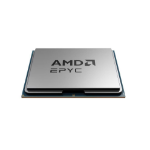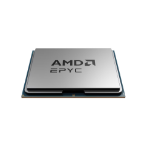We use cookies to make your experience better.
To comply with the new e-Privacy directive, you agree to the privacy policy and our use of cookies.
AMD EPYC 9254 processor 2.9 GHz 128 MB L3
SKU
100-000000480
| Processor socket | Socket SP5 |
|---|---|
| Processor cores | 24 |
| Processor family | AMD EPYC |
| On-board graphics card | No |
| SKU | 100-000000480 |
| EAN | 8592978426194 |
| Manufacturer | AMD |
| Availability | In Stock |
| Product Family | EPYC |
Powering Modern Data Centers
Realize exceptional time-to-results and energy efficiency for your business-critical applications with AMD.
AMD Infinity Guard
Help minimize potential attack surfaces as software is booted, executed, and processes your critical data
AMD Infinity Architecture
Experience unified intelligence.
Realize exceptional time-to-results and energy efficiency for your business-critical applications with AMD.
AMD Infinity Guard
Help minimize potential attack surfaces as software is booted, executed, and processes your critical data
AMD Infinity Architecture
Experience unified intelligence.
| Processor | |
|---|---|
| Processor base frequency | 2.9 GHz |
| Processor manufacturer | AMD |
| Thermal Design Power (TDP) | 200 W |
| Processor cache | 128 MB |
| Processor model | 9254 |
| Processor threads | 48 |
| Processor boost frequency | 4.15 GHz |
| Component for | Server/workstation |
| Processor family | AMD EPYC |
| Processor cores | 24 |
| Processor socket | Socket SP5 |
| Processor cache type | L3 |
| Memory | |
| Memory types supported by processor | DDR5-SDRAM |
| Memory clock speeds supported by processor | 4800 MHz |
| Memory channels | Dodeca-channel |
| Memory bandwidth (max) | 460.8 GB/s |
| Graphics | |
| Discrete graphics card | No |
| On-board graphics card model | Not available |
| On-board graphics card | No |
| Discrete graphics card model | Not available |
| Power | |
|---|---|
| Thermal Design Power (TDP) | 200 W |
| Technical details | |
| PCI Express slots version | 5.0 |
| Thermal Design Power (TDP) | 200 W |
| Market segment | Server |
| Processor cache type | L3 |
| Features | |
| Maximum number of PCI Express lanes | 128 |
| Thermal Design Power (TDP) | 200 W |
| PCI Express slots version | 5.0 |
| Market segment | Server |
You may also be interested in
| Product |

Bestseller
AMD EPYC 9254 processor 2.9 GHz 128 MB...
Login for pricing
|

Recommended
AMD EPYC 9274F processor 4.05 GHz 256...
Login for pricing
|

Popular
Intel Xeon w7-2475X processor 2.6 GHz...
Login for pricing
|

New
AMD EPYC 8434P processor 2.5 GHz 128 M...
Login for pricing
|
 AMD EPYC 7663P processor 2 GHz 256 MB L3
Login for pricing
AMD EPYC 7663P processor 2 GHz 256 MB L3
Login for pricing
|

Hot Product
AMD EPYC 9224 processor 2.5 GHz 64 MB L3
Login for pricing
|
|---|---|---|---|---|---|---|
| SKU |
100-000000480
|
100-000000794
|
PK8071305126800
|
100-000000877
|
100-000001284
|
100-000000939
|
| Description |
Powering Modern Data Centers
Realize exceptional time-to-results and energy efficiency for your business-critical applications with AMD. AMD Infinity Guard Help minimize potential attack surfaces as software is booted, executed, and processes your critical data AMD Infinity Architecture Experience unified intelligence. |
Powering Modern Data Centers
Realize exceptional time-to-results and energy efficiency for your business-critical applications with AMD. AMD Infinity Guard Help minimize potential attack surfaces as software is booted, executed, and processes your critical data AMD Infinity Architecture Experience unified intelligence. |
Intel® Trusted Execution Technology
Intel® Trusted Execution Technology for safer computing is a versatile set of hardware extensions to Intel® processors and chipsets that enhance the digital office platform with security capabilities such as measured launch and protected execution. It enables an environment where applications can run within their own space, protected from all other software on the system. Intel® Virtualization Technology for Directed I/O (VT-d) Intel® Virtualization Technology for Directed I/O (VT-d) continues from the existing support for IA-32 (VT-x) and Itanium® processor (VT-i) virtualization adding new support for I/O-device virtualization. Intel VT-d can help end users improve security and reliability of the systems and also improve performance of I/O devices in virtualized environments. Intel® Virtualization Technology (VT-x) Intel® Virtualization Technology (VT-x) allows one hardware platform to function as multiple “virtual” platforms. It offers improved manageability by limiting downtime and maintaining productivity by isolating computing activities into separate partitions. Intel® 64 Intel® 64 architecture delivers 64-bit computing on server, workstation, desktop and mobile platforms when combined with supporting software.¹ Intel 64 architecture improves performance by allowing systems to address more than 4 GB of both virtual and physical memory. Cache CPU Cache is an area of fast memory located on the processor. Intel® Smart Cache refers to the architecture that allows all cores to dynamically share access to the last level cache. Intel® AES New Instructions Intel® AES New Instructions (Intel® AES-NI) are a set of instructions that enable fast and secure data encryption and decryption. AES-NI are valuable for a wide range of cryptographic applications, for example: applications that perform bulk encryption/decryption, authentication, random number generation, and authenticated encryption. Intel® Turbo Boost Technology Intel® Turbo Boost Technology dynamically increases the processor's frequency as needed by taking advantage of thermal and power headroom to give you a burst of speed when you need it, and increased energy efficiency when you don’t. Max Turbo Frequency Max Turbo Frequency is the maximum single-core frequency at which the processor is capable of operating using Intel® Turbo Boost Technology and, if present, Intel® Turbo Boost Max Technology 3.0 and Intel® Thermal Velocity Boost. Frequency is typically measured in gigahertz (GHz), or billion cycles per second. Execute Disable Bit Execute Disable Bit is a hardware-based security feature that can reduce exposure to viruses and malicious-code attacks and prevent harmful software from executing and propagating on the server or network. Intel® Hyper-Threading Technology Intel® Hyper-Threading Technology (Intel® HT Technology) delivers two processing threads per physical core. Highly threaded applications can get more work done in parallel, completing tasks sooner. Instruction Set An instruction set refers to the basic set of commands and instructions that a microprocessor understands and can carry out. The value shown represents which Intel’s instruction set this processor is compatible with. Intel® VT-x with Extended Page Tables (EPT) Intel® VT-x with Extended Page Tables (EPT), also known as Second Level Address Translation (SLAT), provides acceleration for memory intensive virtualized applications. Extended Page Tables in Intel® Virtualization Technology platforms reduces the memory and power overhead costs and increases battery life through hardware optimization of page table management. Enhanced Intel SpeedStep® Technology Enhanced Intel SpeedStep® Technology is an advanced means of enabling high performance while meeting the power-conservation needs of mobile systems. Conventional Intel SpeedStep® Technology switches both voltage and frequency in tandem between high and low levels in response to processor load. Enhanced Intel SpeedStep® Technology builds upon that architecture using design strategies such as Separation between Voltage and Frequency Changes, and Clock Partitioning and Recovery. Intel® Speed Shift Technology Intel® Speed Shift Technology uses hardware-controlled P-states to deliver dramatically quicker responsiveness with single-threaded, transient (short duration) workloads, such as web browsing, by allowing the processor to more quickly select its best operating frequency and voltage for optimal performance and power efficiency. Intel® Turbo Boost Technology 2.0 Frequency Intel® Turbo Boost Technology 2.0 Frequency is the maximum single core frequency at which the processor is capable of operating using Intel® Turbo Boost Technology. Frequency is typically measured in gigahertz (GHz), or billion cycles per second. Intel® Software Guard Extensions (Intel® SGX) Intel® Software Guard Extensions (Intel® SGX) provide applications the ability to create hardware enforced trusted execution protection for their applications’ sensitive routines and data. Intel® SGX provides developers a way to partition their code and data into CPU hardened trusted execution environments (TEE’s). Intel® Deep Learning Boost (Intel® DL Boost) A new set of embedded processor technologies designed to accelerate AI deep learning use cases. It extends Intel AVX-512 with a new Vector Neural Network Instruction (VNNI) that significantly increases deep learning inference performance over previous generations. Instruction Set Extensions Instruction Set Extensions are additional instructions which can increase performance when the same operations are performed on multiple data objects. These can include SSE (Streaming SIMD Extensions) and AVX (Advanced Vector Extensions). Intel® Turbo Boost Max Technology 3.0 Frequency Intel® Turbo Boost Max Technology 3.0 identifies the best performing core(s) on a processor and provides increased performance on those cores through increasing frequency as needed by taking advantage of power and thermal headroom. Intel® Turbo Boost Max Technology 3.0 frequency is the clock frequency of the CPU when running in this mode. Intel® Turbo Boost Max Technology 3.0 Intel® Turbo Boost Max Technology 3.0 identifies the best performing core(s) on a processor and provides increased performance on those cores through increasing frequency as needed by taking advantage of power and thermal headroom. Intel® Total Memory Encryption TME – Total Memory Encryption (TME) helps protect data against exposure via physical attack on memory, such as cold-boot attacks. Max # of UPI Links Intel® Ultra Path Interconnect (UPI) links are a high speed, point-to-point interconnect bus between the processors, delivering increased bandwidth and performance over Intel® QPI. # of AVX-512 FMA Units Intel® Advanced Vector Extensions 512 (AVX-512), new instruction set extensions, delivering ultra-wide (512-bit) vector operations capabilities, with up to 2 FMAs (Fused Multiply Add instructions), to accelerate performance for your most demanding computational tasks. Intel® Resource Director Technology (Intel® RDT) Intel® RDT brings new levels of visibility and control over how shared resources such as last-level cache (LLC) and memory bandwidth are used by applications, virtual machines (VMs) and containers. Intel® Optane™ Persistent Memory Supported Intel® Optane™ persistent memory is a revolutionary tier of non-volatile memory that sits between memory and storage to provide large, affordable memory capacity that is comparable to DRAM performance. Delivering large system-level memory capacity when combined with traditional DRAM, Intel Optane persistent memory is helping transform critical memory constrained workloads – from cloud, databases, in-memory analytics, virtualization, and content delivery networks. Mode-based Execute Control (MBEC) Mode-based Execute Control can more reliably verify and enforce the integrity of kernel level code. Intel® Boot Guard Intel® Device Protection Technology with Boot Guard helps protect the system’s pre-OS environment from viruses and malicious software attacks. Intel® Control-Flow Enforcement Technology CET - Intel Control-flow Enforcement Technology (CET) helps protect against the misuse of legitimate code snippets through return-oriented programming (ROP) control-flow hijacking attacks. Intel® Transactional Synchronization Extensions Intel® Transactional Synchronization Extensions (Intel® TSX) are a set of instructions that add hardware transactional memory support to improve performance of multi-threaded software. |
Powering the Intelligent Edge
Optimized for cloud services, intelligent edge, and telco deployments AMD Infinity Guard Help minimize potential attack surfaces as software is booted, executed, and processes your critical data AMD Infinity Architecture Experience unified intelligence. |
AMD Infinity Guard
Help minimize potential attack surfaces as software is booted, executed, and processes your critical data AMD Infinity Architecture Experience unified intelligence. |
Powering Modern Data Centers
Realize exceptional time-to-results and energy efficiency for your business-critical applications with AMD. AMD Infinity Guard Help minimize potential attack surfaces as software is booted, executed, and processes your critical data AMD Infinity Architecture Experience unified intelligence. |
| Short Description |
2.9 GHz, 24 CPU Core, L3 128 MB, SP5, TDP 200W
|
4.05 GHz, 24 CPU Core, L3 256 MB, SP5, TDP 320W
|
PK8071305126800
|
Socket SP6, 48 cores, 96 threads, 2.5 GHz base clock, 3.1 GHz boost clock, 128 MB cache, 200 W TDP
|
Socket SP3, 56 cores, 112 threads, 2 GHz base clock, 3.5 GHz boost clock, 256 MB cache, 240 W TDP
|
2.5 GHz, 24 CPU Core, L3 64 MB, SP5, TDP 200W
|
| Manufacturer |
AMD
|
AMD
|
Intel
|
AMD
|
AMD
|
AMD
|



